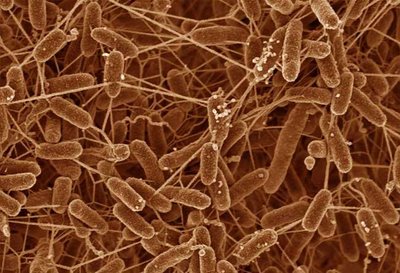Living batteries and the wire garden

"Bacteria can be persuaded to produce wire-like appendages that conduct electricity," New Scientist reports. These wires are shown in the image, above: a bio-geometrical tangle.
"A deficit of metal atoms in the close vicinity of the bacteria can cause a bottleneck," we read, "so the proliferation of nanowires allows the bacteria to consume more fuel." In other words, the bacteria can use these metal atoms as structural parts of their own "bodies," as they interact with and metabolize the immediate environment – in which case, does this constitute a kind of living metal? That simultaneously doubles as an electrical appliance?
"Now a study by Yuri Gorby of Pacific Northwest National Laboratories in Washington State, US and colleagues reveals that several other kinds of bacteria produce similar nanowires." And in ten years' time, your own dear son will start sprouting extension cords... You can plug Hoovers into him.
Meanwhile, Gorby studies something called biogeochemistry.
So will the electrical network installed in the walls of your house become a living thing someday, an organism of light and electricity, made of wires, prone to growing so you have to prune it back on Saturdays, a new chore – electro-topiary? Or you'll grow whole gardens of the electrically self-modified, vines and ivy coiling through the undergrowth, lit up like Christmas lights, shining.
Wire gardens.





Comments are moderated.
If it's not spam, it will appear here shortly!
Everytime I read about these new bacteriological species and capacities, I immediately imagine them mutating out of control, going airborn, or something. Maybe it’s a misconception, but all these new biomimetic technologies seem even more dangerous than atomic tests, fierce petrochemicals, etc. It takes just one bacterial escapee to launch the world into a good sci-fi flick. A scientist comes home with a bad head cold, and suddenly sneezes out a huge branch of voltage that fries his television set – and infects it at the same time -
I SING the Body electric;
The armies of those I love engirth me, and I engirth them;
They will not let me off till I go with them, respond to them,
...
Was it doubted that those who corrupt their own bodies conceal themselves;
And if those who defile the living are as bad as they who defile the dead?
And if the body does not do as much as the Soul?
And if the body were not the Soul, what is the Soul?
...
The sprawl and fulness of babes, the bosoms and heads of women, the folds of their dress, their style as we pass in the street, the contour of their shape downwards,
The swimmer naked in the swimming-bath, seen as he swims through the transparent green-shine, or lies with his face up, and rolls silently to and fro in the heave of the water,
...
A man’s Body at auction;
I help the auctioneer—the sloven does not half know his business.
Gentlemen, look on this wonder!
...
Examine these limbs, red, black, or white—they are so cunning in tendon and nerve;
They shall be stript, that you may see them.
Exquisite senses, life-lit eyes, pluck, volition,
Flakes of breast-muscle, pliant back-bone and neck, flesh not flabby, good-sized arms and legs,
And wonders within there yet.
Within there runs blood,
The same old blood!
The same red-running blood!
There swells and jets a heart—there all passions, desires, reachings, aspirations;
Do you think they are not there because they are not express’d in parlors and lecture-rooms?
...
oops.
http://www.bartleby.com/142/19.html
The wonderful part about this kind of study is that these species have been around all the time, invisibly underlying all our homes and gardens, pulsing with nanoscopic amounts of electricity.
It is impossible to culture the majority of them on petri dishes or the like, but strictly taking up the DNA and testing it for sequence identity reveals a species density of something like 10^6 types bacterial species per gram of soil.
If you look into Gorby's work, you'll find that it is not only this wiring found in anaerobic metal-reducing bacteria that might be expected to produce some sort of conductive appendages, but also in the cyanobacteria that blanket the oceans. Which is to say that those giant green blooms visible on google satellite view may form a larger electrical network (in terms of connections) than all of human civilization.
Of course this is only hearsay . . .
To museum_of_ephemerata: I don't believe these are genetically engineered species of bacteria. They are simply existing species that we are learning more about. So there's no danger of an "escape", since they're already present in the environment.
Post a Comment